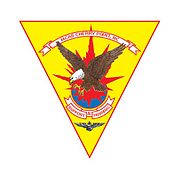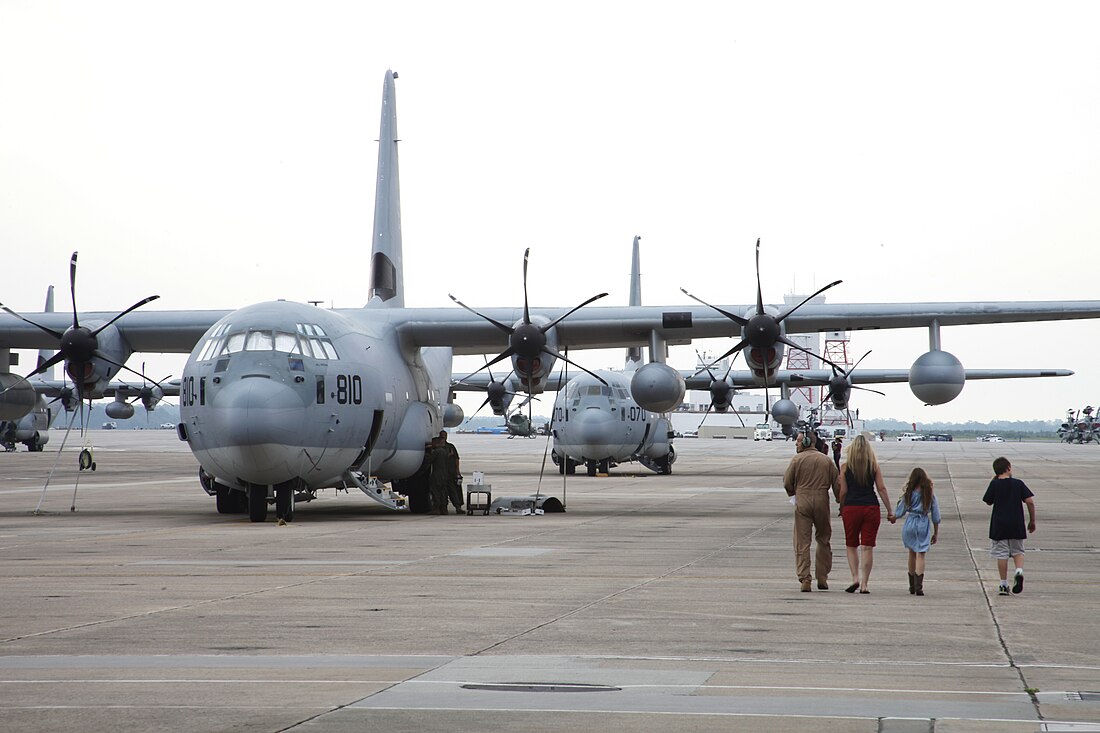Marine Corps Air Station Cherry Point
US Marine Corps base in Havelock, North Carolina, United States From Wikipedia, the free encyclopedia
Marine Corps Air Station Cherry Point or MCAS Cherry Point (*34.9009°N 76.8807°W) (ICAO: KNKT, FAA LID: NKT) is a United States Marine Corps airfield located in Havelock, North Carolina, United States, in the eastern part of the state. It was built in 1941, and was commissioned in 1942 and is currently home to the 2nd Marine Aircraft Wing.
| Marine Corps Air Station Cherry Point | |||||||||||||
|---|---|---|---|---|---|---|---|---|---|---|---|---|---|
Cunningham Field | |||||||||||||
| Havelock, North Carolina in the United States | |||||||||||||
 KC-130J Hercules of VMG-252 on the flight-line MCAS Cherry Point. | |||||||||||||
 | |||||||||||||
| Coordinates | 34°54′03″N 076°52′51″W | ||||||||||||
| Type | Marine Corps Air Station | ||||||||||||
| Site information | |||||||||||||
| Owner | Department of Defense | ||||||||||||
| Operator | US Marine Corps | ||||||||||||
| Controlled by | Marine Corps Installations – East | ||||||||||||
| Condition | Operational | ||||||||||||
| Site history | |||||||||||||
| Built | 1942 | ||||||||||||
| In use | 1942 – present | ||||||||||||
| Garrison information | |||||||||||||
| Current commander | Colonel Brendan Burks | ||||||||||||
| Garrison | 2nd Marine Aircraft Wing | ||||||||||||
| Airfield information | |||||||||||||
| Identifiers | ICAO: KNKT, FAA LID: NKT, WMO: 723090 | ||||||||||||
| Elevation | 8.8 metres (29 ft) AMSL | ||||||||||||
| |||||||||||||
| Other airfield facilities | 5x V/STOL pads | ||||||||||||
| Source: Federal Aviation Administration[1] | |||||||||||||
History
Summarize
Perspective
Congress authorized Marine Corps Air Station Cherry Point on 9 July 1941, with an initial appropriation of $14,990,000 for construction and clearing of an 8,000 acre (32 km2) tract of swamps, farms and timberland.
Actual clearing of the site began on 6 August 1941, with extensive drainage and malaria control work. Construction began in November just 17 days before the attack on Pearl Harbor.

On 20 May 1942, the facility was commissioned Cunningham Field, named in honor of the Marine Corps' first aviator, Lieutenant Colonel Alfred A. Cunningham. The completed facility was later renamed Marine Corps Air Station Cherry Point, after a local post office situated among cherry trees.
Cherry Point's primary World War II mission was to train units and individual Marines for service to the Pacific theater. The air station also served as a base for anti-submarine operations, with an Army Air Forces (22d Antisubmarine Squadron) and later a Navy squadron each being responsible for the sinking of a German U-boat just off the North Carolina coast during 1943.
Cherry Point's contribution to the Korean War effort was to provide a steady stream of trained aviators and air crewmen as well as maintenance and support personnel as replacements to forward deployed aviation units.
During the Vietnam War, Cherry Point deployed three A-6 Intruder squadrons to the Far East and again provided a constant source of replacements for aircrews and enlisted aviation personnel.
In Operation Desert Storm, Cherry Point was a major contributor to the victory in Southwest Asia by supporting the deployment of three AV-8B Harrier squadrons, two A-6E Intruder squadrons, one KC-130 Hercules squadron, one EA-6B Prowler squadron, and headquarters detachments from Marine Aircraft Group 14, Marine Aircraft Group 32, and the 2nd Marine Aircraft Wing.
Cherry Point Marines and Navy Corpsmen participated in strike missions and follow-on operations in Afghanistan and its surrounding region during Operation Enduring Freedom, which was initiated on 7 October 2001.
On 8 September 2007, the headquarters building (198) was gutted by a fire.[2] The groundbreaking ceremony for the new Headquarters Building was on 29 July 2009, with completion planned for sometime in 2011.
The air station and its associated support locations occupy more than 29,000 acres (120 km2). Its runway system is large enough that the air station served as an alternate emergency landing site for the Space Shuttle launches out of Cape Canaveral, Florida.[3][4]
In 2013, Cherry Point hosted warfighters, technology teams and testers under the flags of 10 nations and each of the U.S. military services for the 11th Bold Quest coalition demonstration. The Joint Staff, J6 Joint Deployable Analysis Team (JDAT) led the test plan design, execution control, and emplaced the necessary infrastructure to connect the numerous geographic sites across seven states. Cherry Point was chosen for its ideal location for hosting East Coast military assets, supporting two U.S. Navy warships operating offshore, the Arleigh Burke-class guided missile destroyer USS Jason Dunham (DDG-109) and Ticonderoga-class guided missile cruiser USS San Jacinto (CG-56).[5]
In 2024, VMFA-251 received their first Joint Strike Fighter aircraft, making it the first active duty F-35C Lightning II squadron on the East Coast. [6]
USAF use
On 1 July 1957 the United States Air Force (USAF) 614th Airborne Control and Warning Squadron established an Air Defense Command Phase I Mobile Radar station (M-116) at Cherry Point. This station was part of the planned deployment of forty-four Mobile radar stations. The USAF activated an AN/FPS-6 and two AN/FPS-8 radars located adjacent to Base Flight Operations. These radars were placed on top of 90-foot (27 m) towers without radomes, and initially the station functioned as a Ground-Control Intercept (GCI) and warning station. As a GCI station, the squadron's role was to guide interceptor aircraft toward unidentified intruders picked up on the unit's radar scopes.
In addition to the radars on the air station, two unmanned AN/FPS-14 "Gap Filler" sites, one at Engelhard, NC (M-116B) 35°29′49″N 076°00′34″W and one at Holly Ridge, NC (M-116C) 34°30′50″N 077°32′08″W were set up for additional coverage.
One of the AN/FPS-8s was damaged by Hurricane Donna in 1960. The radars were turned over to the Navy on 30 April 1960, and the Marine Corps retained the other undamaged AN/FPS-8 radar for a number of years for base air traffic control.
During 1961 M-116 joined the Semi Automatic Ground Environment (SAGE) system, initially feeding data to DC-04 at Fort Lee AFS, Virginia. After joining, the squadron was re-designated as the 614th Radar Squadron (SAGE) on 1 March 1963. The radar squadron provided information 24/7 the SAGE Direction Center where it was analyzed to determine range, direction altitude speed and whether or not aircraft were friendly or hostile.
USAF radar operations continued at MCAS Cherry Point until 1 August 1963 when budget reductions and a general draw-down of antiaircraft radar sites closed the facility.[7][8]
Based units
Summarize
Perspective
Flying and notable non-flying units based at MCAS Cherry Point.[9][10][11][12]
United States Marine CorpsMarine Corps Installations – East
|
United States Navy
|
Supported facilities
MCAS Cherry Point also maintains a number of satellite airfields:
- MCALF Bogue, a staffed installation in Bogue Sound, North Carolina which is used for Field Carrier Landing Practice.[13]
- MCOLF Oak Grove, a minimally staffed outlying airfield near Pollocksville, North Carolina specializing in operations on unimproved surfaces in a reduced visibility environments.[14]
- MCOLF Atlantic, an outlying airfield near Atlantic, North Carolina used as an arming and refueling point and base for rotary-wing base supporting training activities in the region.[15]
Several former outlying landing fields have been converted to regional airports, such as MCOF Greenville, MCAA Kinston, MCASE near Edenton NC and MCOF New Bern.
See also
References
External links
Wikiwand - on
Seamless Wikipedia browsing. On steroids.

